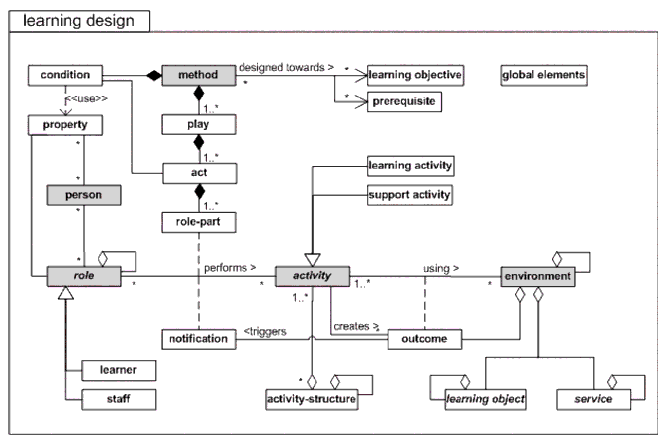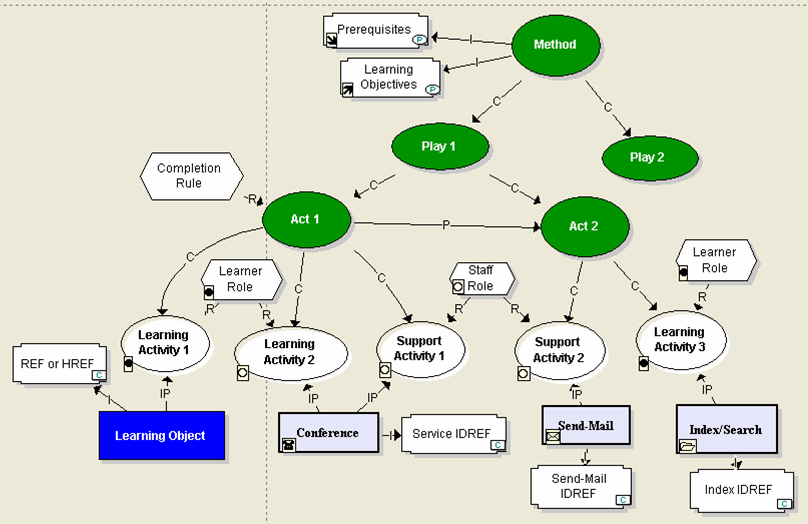IMS Learning Design
Definition
- IMS Learning Design is a formal pedagogical standard, a (educational modeling language) to describe technology supported pedagogical scenarios based on rich instructional design models.
- IMS Learning Design as opposed to IMS Simple Sequencing/SCORM focuses on the organization of learning activities.
- LD has evolved from Educational Markup Language (EML).
The theatre metaphor
In IMS LD terminology a pedagogical scenario is called a play. Major components of this design are:
- roles that are performed by learners, teachers, tutors etc.
- activities
- environments including services (e.g. a forum) and learning resources
- The scenario itself is called method and contains play, act and role-parts.
The play is presented in a series of acts, in which roles are played by those taking part, for example learner, tutor, mentor, and so on.
- People playing the roles undertake a series of activities within an act. For a learner these might include discussing with classmates the relative merit of a piece of source material. A tutor’s activity may be to comment on their conclusions.
- Each role is presented with its own learning objects and services (e.g. communication tools) within an activity.
- An act is completed after all the activities of a specified role, or roles, are finished. Alternatively, a time limit may be set, after which an act completes.
- When one act completes, the next act is started. The play finishes when all the acts are completed; the learning design finishes when all the plays are completed.
The play metaphor has probably been chosen because as in a play LD scenarios can be played differently, with different actors and different props.
Conceptual Structure of the Learning Design
A level architecture
According to the CETIS Briefing on Learning Design:
- Level A contains the core of IMS Learning Design: people, activities and resources, and their coordination through the method, play, act and role-parts elements. This simply provides for a series of time ordered learning activities to be performed by learners and teachers, using learning objects and/or services.
- Level B adds greater control and complexity through the use of properties and conditions.
- Properties may be internal (local) or external (global). They are used to store information about a person, such as test results or learner preferences; a role, such as whether the role is for a full-time or part-time learner; or a learning design itself. Internal properties persist only during a single run of a learning design, while external properties retain their values beyond the end of a run, and can be accessed from different runs and/or different learning designs.
- Level C offers the opportunity for more sophisticated learning designs through notifications (messaging), which allow for notification of new activities to be triggered automatically in response to events in the learning process. It enables the automation of learning flow activities, which are triggered by the completion of tasks, rather than the learning flows being pre-planned.
- For instance, a teacher may be notified by email that an assignment has been submitted and needs marking; once the score has been posted, the learner may be notified to undertake a new activity according to the result.
An overall view
An official UML Diagram summarizes the LD modelling language:
An easier to understand picture has been made by Gilbert Paquette and/or Michel Léonard as an example ontology for their MOTPlus authoring tool:
Major learning design elements
The following table (copied from the Reload WebSite (18:43, 11 December 2006 (MET)) summarizes the hierarchy of the learning design elements.
learning-design |
The base level container |

